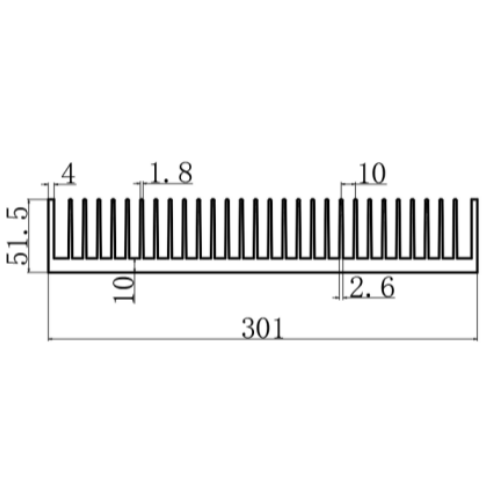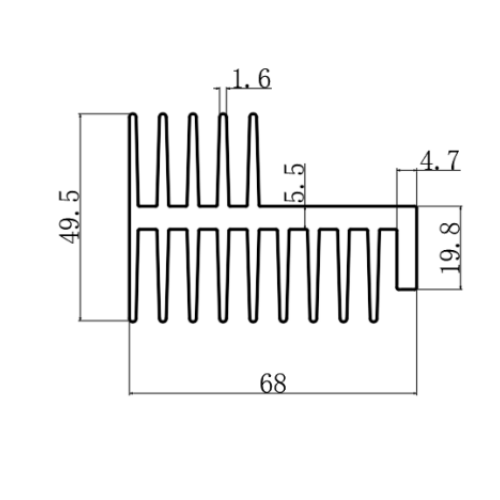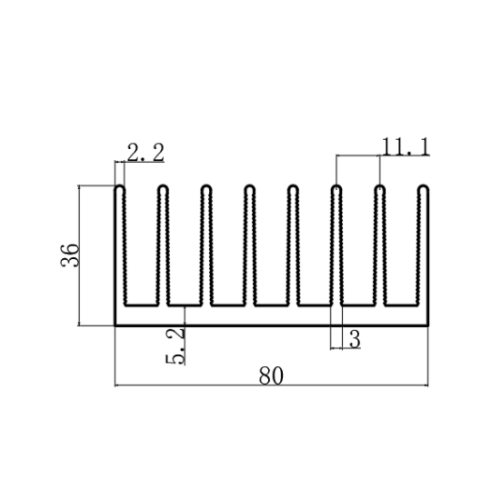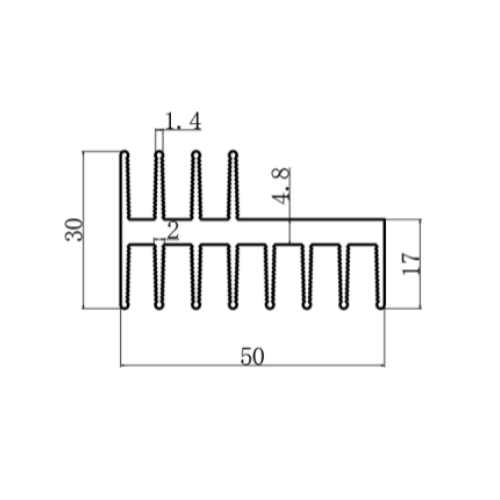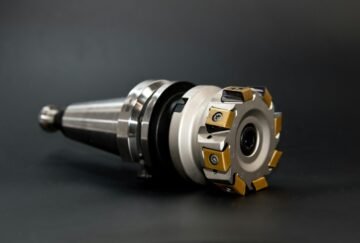Description
1. Introduction to the 301×51.5mm Aluminum Heatsink(PDF Drawing Download)
The 301×51.5mm aluminum heatsink redefines thermal management for high-density electronic systems, combining aerospace-grade extrusion techniques with rigorous engineering to deliver 40% higher heat dissipation efficiency than standard die-cast models. Designed for applications where every millimeter counts—such as server racks, 5G infrastructure, and medical imaging devices—this heatsink leverages the natural thermal conductivity of 6063-T6 aluminum alloy (180 W/m·K) to maintain component temperatures below critical thresholds, even under sustained 500W loads.
2. Precision Extrusion Technology & Design Innovations
Why Extrusion Matters
Extruded aluminum heatsinks outperform stamped or bonded alternatives due to their monolithic structure, eliminating weak joints and delamination risks. The 301×51.5mm design incorporates:
-
Variable Fin Geometry: Tapered fins (2mm base to 1mm tip) reduce airflow resistance by 22% while maximizing surface area.
-
Asymmetric Base Plate: A 10mm-thick base under heat sources ensures uniform heat spreading, validated by ANSYS CFD simulations.
-
Hybrid Cooling Channels: Optional integration with heat pipes or vapor chambers for localized hotspot mitigation.

*Alt text: “301×51.5mm aluminum heatsink cooling high-density server components”*
3. Technical Specifications & Performance Metrics
Key Advantages
-
Passive Cooling Dominance: Sustains 400W loads without forced airflow (ambient ≤35°C).
-
Corrosion Resistance: Withstands 2000-hour salt spray tests (ASTM B117).
-
EMI Shielding: Anodized coating reduces electromagnetic interference by 30%.
4. Industrial Applications
The 301×51.5mm aluminum heatsink excels in high-stakes environments:
-
Data Centers:
-
Cooling NVIDIA A100 GPUs and AMD EPYC processors in AI server clusters.
-
Compatible with Open Compute Project rack standards.
-
-
5G Telecommunications:
-
Thermal management for mMIMO antennas and RF power amplifiers.
-
-
Medical Imaging:
-
Stabilizing temperatures in MRI gradient coils and X-ray generators.
-
For niche applications, explore our custom heatsink solutions.
5. Comparative Analysis: Extruded vs. Die-Cast Heatsinks
| Criterion | 301×51.5mm Extruded Heatsink | Die-Cast Heatsink |
|---|---|---|
| Thermal Conductivity | 180 W/m·K | 120 W/m·K |
| Production Lead Time | 3 weeks | 8–12 weeks |
| Tooling Cost | $0 (no custom dies) | $15,000+ |
| Max Operating Temp | 160°C | 100°C |
Extruded designs enable rapid prototyping and superior thermal performance.
6. Installation Guide for High-Heat Environments
-
Surface Preparation:
-
Degrease with isopropyl alcohol; achieve surface flatness ≤0.1mm/m.
-
-
Thermal Interface Material:
-
Use graphite pads (e.g., Panasonic PY-22) for low-contact-pressure scenarios.
-
-
Mounting Hardware:
-
Secure with spring-loaded screws (0.8–1.2 N·m torque) to accommodate thermal expansion.
-
Watch our step-by-step installation video for best practices.
7. Case Study: 5G Base Station Thermal Optimization
A telecom provider deployed the 301×51.5mm aluminum heatsink in urban 5G nodes, achieving:
-
45°C → 32°C: Average temperature drop in power amplifiers.
-
Zero Downtime: During summer peak loads (40°C ambient).
-
20% Energy Savings: Reduced cooling fan usage.
Download the full IEEE thermal management report for technical insights.
8. Sustainability & Compliance
-
Recyclability: 100% recyclable aluminum, aligned with ASM Sustainability Standards.
-
Low Carbon Footprint: Extrusion consumes 60% less energy than die-casting.
-
Certifications: UL Recognition (E492498), CE Marking.
9. FAQs
Q: Can this heatsink handle cyclic thermal shocks?
A: Yes! Tested for 10,000 cycles (-40°C ↔ +125°C) without performance degradation.
Q: Is it compatible with liquid cooling systems?
A: Absolutely. Pre-drilled ports for 1/4″ NPT fittings are available upon request.
Q: How does fin density impact performance?
A: Higher fin density improves heat dissipation but increases airflow resistance. Read our guide for optimization tips.
10. Resources & Support
-
White Papers:
-
Tools:
-
Videos:
